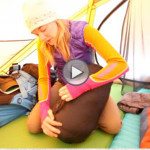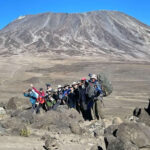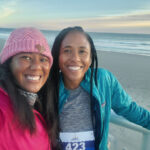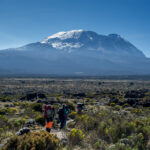Watch as I run through the packing list in the Thomson Kili Prep Guide.
Check the packing tips page on our site for more details on what to pack.
My name is John King. I’m one of Thomson Safaris’ staffers, and I’m getting ready to climb Kilimanjaro’s Western Approach.
What’s special about me climbing? Nothing! I’m not a former Olympian or a skyrunner. I’m not even a casual mountaineer; the highest I’ve been is about 5,100 feet when I visited Denver, CO in 2017.
My story’s not special, and that’s the perfect reason for you to read about me. Here’s how a completely run-of-the-mill guy gets to the Roof of Africa.
1. Train Diligently and Don’t Go Overboard

Strength and endurance are critical for summiting Kili, but extreme strength and endurance are not. Regardless, I would start training as soon as you make your Kilimanjaro plans – three months of training at a minimum.
On average, I’ll hike about 5 miles for 5 hours at a 30 percent grade over seven days going up the mountain. No technical mountaineering skill is required; it’s all hiking with perhaps a little scrambling up the Barranco Wall.
In a vacuum, I consider that an achievable amount of activity for a novice. Consult your physician if you aren’t so sure.
Altitude makes the trek more physically intense, especially on the last day when you’re trekking to the summit. The higher you go up the mountain, the harder your body will need to work due to the drop in air pressure and oxygen content in the air.
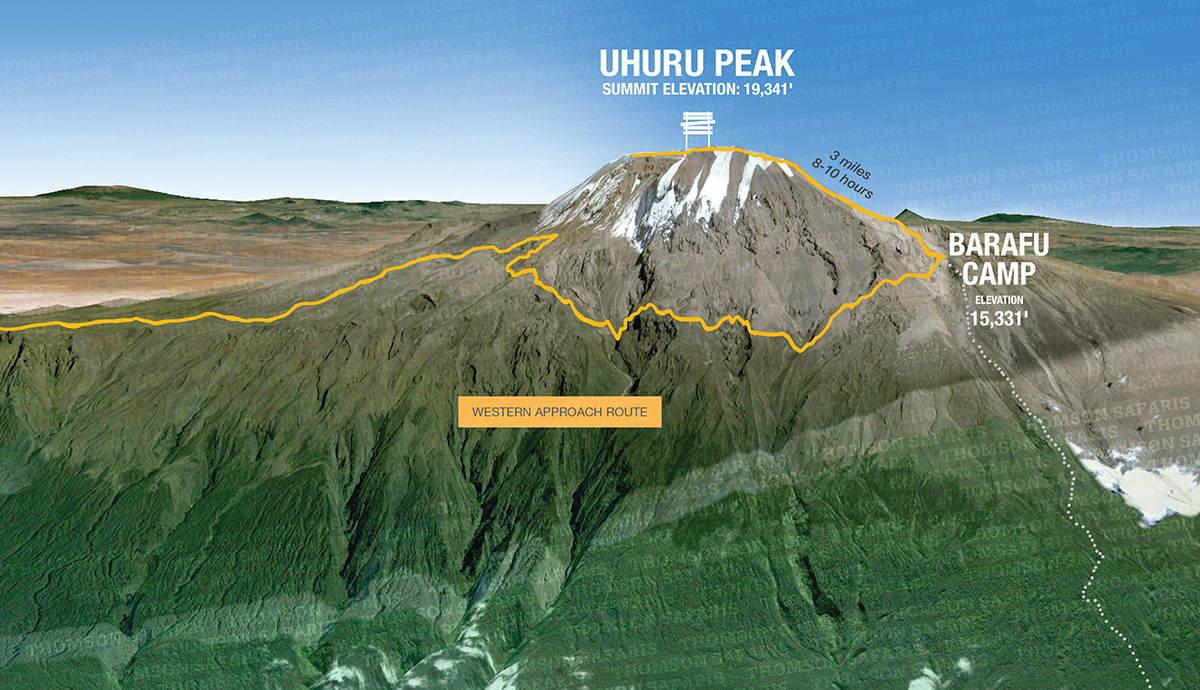
The last day of my ascent, will be the 8- to 10-hour climb from Barafu (15,331 feet) to Uhuru peak (19,341 feet). That’s what’s on my mind while I train.
A colleague of mine put it best:
Summiting Kilimanjaro is a mental challenge first, but when the going got tough and the effects of altitude kicked in, I relied on my physicality to carry me on summit day.
 That’s all the perspective I needed to take my training seriously, which is mostly a consistent rotation of running, stairs and leg strength training.
That’s all the perspective I needed to take my training seriously, which is mostly a consistent rotation of running, stairs and leg strength training.
If you’re not sure where to start or you’re the least bit hesitant about your fitness discipline, I highly recommend Fit For Trips, which crafts personalized fitness programs based on your adventure travel itinerary. I worked with Fit For Trips myself, and it made all the difference. You can get 25 percent off your program as a Thomson trekker as well.
2. Schedule an Appointment with a Travel Doctor

Altitude is the primary obstacle between trekkers and Uhuru Peak. A trip to the travel doctor will really hammer this point home, and you can settle any immunization or health concerns at the same time.
I’ve been researching for my Kilimanjaro trek for a fair amount of time, and my travel doctor still shared information I didn’t know. Advice about altitude medications, trekking routes, explanations about altitude’s effects on the body and how to mitigate those effects – I would easily call the appointment one of the most important things I did to prepare.
I can’t share medical recommendations, but I will say my doctor was very happy to hear I was taking the 9-day Western Approach route. Extra acclimatization time can significantly help mitigate altitude symptoms. Not a bad choice for someone who has spent most of his life around sea level.
3. Subscribe to Adventure Travel Gear Suppliers and Watch Out for Deals

I’ve hiked a fair amount, but none of my travels required the gear necessary for climbing Kilimanjaro. That said, I needed to buy a lot of clothing and equipment. This was a little daunting, but going through our packing list item-by-item made things simple.
Look out for deals offered by REI, Eddie Bauer, SmartWool and other travel gear suppliers. Sign up for their newsletters now. I saved hundreds of dollars just by checking my email and taking advantage of sales.
I often found myself questioning whether certain gear was built for mountaineering or not. If you want to cut to the chase, browse our Kilimanjaro Store. Items are listed specifically with Kili trekking in mind.
4. Rent Everything Else
Fleeces, jackets, gloves – I bought plenty of things I’ll use again. Then there are things like Gore-Tex shell pants, trekking poles and gaiters. They’re all necessary for Kilimanjaro, but I wasn’t sure if I’d use them again.
Absolutely rent things you feel you won’t use again. Not only can you save a few hundred dollars, you’ll save tons of space in your luggage. I have a heavy weight jacket, Gore-Tex shells, a sleeping bag and more waiting for me in Tanzania, and I couldn’t be happier.
5. Believe in Yourself and Don’t Worry
I think it’s normal to feel some doubt and worry while preparing for Kilimanjaro, especially for a novice trekker. I’ve experienced it maybe a hundred times in a hundred different ways.
- Is this fleece going to be warm enough?
- What if the weather at the summit is too extreme?
- How is altitude going to affect me?
- Do I really know what I’m getting into?
Sometimes it’s productive. These worries might help you research things a little more carefully – like which gear will hold up best on the mountain or what workout routine will get you to the summit.
Other times, it simply isn’t. You have no control over the weather, and most people have no way of testing how altitude will affect them, at least not in the contiguous United States.
My solution is this: ask people who have climbed Kilimanjaro about their experience and think carefully about whether your concerns should overcome an adventurous spirit.
I’m fortunate enough to speak with people who have trekked every day – colleagues, grandparents, you name it. The overwhelming response I’ve received is something to the tune of, “it was incredible, and you should do it!” That’s enough to get me on board.
And if it wasn’t, I would consider this: with the right trekking strategy and preparation, your odds of summit success increase to 98 percent. The overwhelming majority of our trekkers get to the summit and back without issue. Two percent isn’t enough to discourage me, and I don’t think it should discourage you either.



